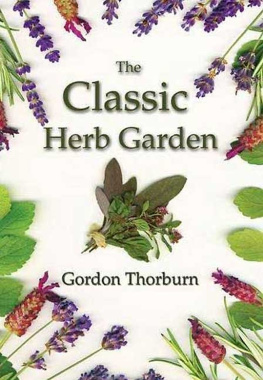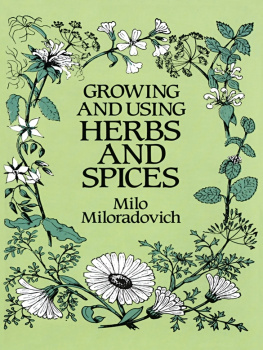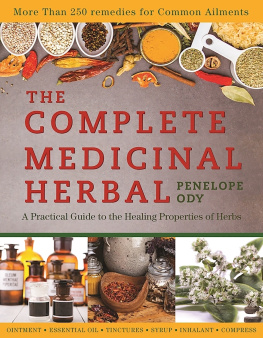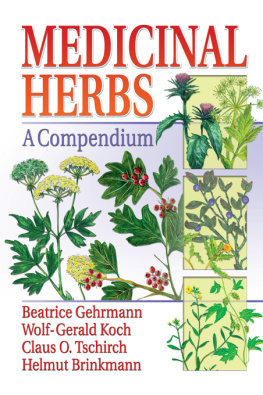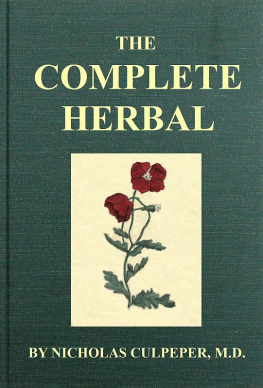BREVERTONS COMPLETE HERBAL

BREVERTONS COMPLETE HERBAL
A Book of Remarkable Plants and Their Uses
Based on Culpepers The English Physitian of 1652 and Compleat Herball of 1653
Terry Breverton

CONTENTS
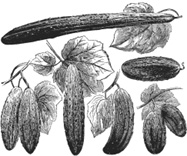
I
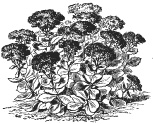
INTRODUCTION

This book is intended to be both entertaining and informative. It is written in part as a homage to the knowledge of our forebears and to the memory of a remarkable maverick, a man who wished to bring medical knowledge to those who could not afford the prices and fees of apothecaries and doctors. Apart from three pages devoted to this polymath, Nicholas Culpeper (see pages 122124), whose The English Physitian (1652) and Compleat Herball (1653) have been continuously in print since the 17th century, it consists of either single-page or double-page entries about all the most interesting herbs, spices and associated herb gardens and gardeners. The book is arranged in alphabetical order by common name, with just a very few entries being slightly out of sequence to ensure that each double-page entry appears on a natural spread of the book. Most spellings have been modernized.
Please note: do not try any of these remedies without first consulting a qualified doctor.
Nicholas Culpeper (161654) not only gave very full descriptions of the Government and Virtues of each herb or spice that he described, but also its other common names, astrological notes, a full description of all its parts so one could recognize it when gathering herbs, the places where it grew and when to pick it. In his books, he listed all the known herbal remedies of the time, wishing to create a book that would help ordinary people make their own herbal remedies. An astrologer, herbalist, physician and botanist, Culpeper gathered and cataloged hundreds of medicinal herbs, and severely criticized his medical contemporaries for their restrictive practices, writing in his foreword: This not being pleasing, and less profitable to me, I consulted with my two brothers, DR. REASON and DR. EXPERIENCE, and took a voyage to visit my mother NATURE, by whose advice, together with the help of DR. DILIGENCE, I at last obtained my desire; and, being warned by MR. HONESTY, a stranger in our days, to publish it to the world, I have done it. Of course, he was hated by the medical menthe surgeons, doctors and apothecaries of his timeand his name was blackened in his lifetime and his reputation besmirched after his early death.

Herbalism is the oldest known method of systematic healing. Many of todays herbs are known to have been used therapeutically for thousands of years. The word herb refers to a plant of which the leaves, flowers, stems or roots are used for food, flavoring, scent or medicine. Many have multiple uses, e.g. marjoram can be used for flavoring, scent, healing and dyeing. So-called pot herbs could be used in pottage the staple stew of the people, and in cooking pots; salets or salad herbs went into salads with olive oil and vinegar. Apart from their use as remedies and preventative medicines and in cooking, herbs have long been employed as disinfectants, as perfumes and air fresheners, dyes, cosmetics, as companion plants, as insect and animal repellents and attractors, and even as currency. The distinction between a herb and a spice is this: herbs are the fresh and dried leaves generally of temperate plants, often green in color. Spices are the flowers, fruit, seeds, bark and roots typically of tropical plants, which range from brown to black to red in color. Usually, spices have a more pungent flavor than herbs, but it is possible for one plant to provide both a herb and a spice, e.g. Coriandrum sativums leaves are used as the herb cilantro and the seed is the spice coriander.
The first botanic gardens for educating schools of herbalists were founded in Padua, Italy in 1545 and in Oxford, England in 1621. These schools effectively took medicine out of the hands of the monks tending the monastic gardens, and placed it under the control of physicians. Newly trained doctors began to lecture on the healing properties of herbs, and their reliance on leeching, or bleeding, and chemical alchemy was largely replaced by the study of herbal alchemy. Alongside them, apothecaries, the chemists of the Middle Ages, had a near monopoly upon the supply of herbs and spices, and worked closely with the physicians. In the 17th century there was a great influx of herbs from the New World as a result of the Spanish and Portuguese conquests, and a number of herbals were published, written by doctors for doctors and apothecaries. It signaled a breakthrough in healing, with the authors focusing upon the botanical properties and characteristics of plants themselves rather than on humours, planetary influences and the Doctrine of Signatures (the belief that some plants had been signed by God to indicate their uses by virtue of the way they appeared).
The common people had traditionally been forced to rely upon local wise women for cheap treatment of illnesses, and many of these women, who relied upon the oral herbal tradition, were burned as witches across Europe. With the publication of Culpepers works, people could begin to treat themselves, often for free, rather than go to an apothecarys shop. Many plants have the Latin suffix officinalis in their botanic name signifying that they were of the shop, i.e. approved for sale by apothecaries. Culpepers publications combined traditional plant lore with descriptions of the medicinal properties of the herbs and their astrological indicators. Many of his herbs and spices have been found to have extremely valuable properties in treating illnesses, and multiple other uses, and they remain as valuable to us today as they were in Culpepers own time.
ADDERS TONGUE
OPHIOGLOSSUM VULGATUM
Family Ophioglossaceae

OTHER NAMES: Adders tongue fern, common adders tongue, English adders tongue, snakes tongue, vipers tongue, serpents tongue, adders-tongue fern, southern adders tongue, adders spear, Christs spear. (This is not the American adders-tongue, which is an Erythronium, but O. vulgatum is native across much of the USA).
DESCRIPTION: A genus of about 2530 species, the perennial adders tongues are so named because the spore-bearing stalk resembles a snakes tongue. It has no resemblance to any other fern, and has much the appearance of a small arum flower. The plant grows from a central, budding, fleshy structure to 36 inches (815 cm) tall and has a two-part frond, forming a rounded diamond-shaped sheath and a narrow spore-bearing spike which can grow taller than its leaf. Culpepers description indicates that his variety was the O.
Next page





